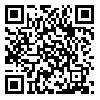Volume 8, Issue 3 (September 2021)
Health Spiritual Med Ethics 2021, 8(3): 149-154 |
Back to browse issues page
Download citation:
BibTeX | RIS | EndNote | Medlars | ProCite | Reference Manager | RefWorks
Send citation to:



BibTeX | RIS | EndNote | Medlars | ProCite | Reference Manager | RefWorks
Send citation to:
Khormaei F, Ghaemi M, Yadollahi P. The Structural Model of Militancy/Peacefulness Morality Association With Psychological Wellbeing. Health Spiritual Med Ethics 2021; 8 (3) :149-154
URL: http://jhsme.muq.ac.ir/article-1-428-en.html
URL: http://jhsme.muq.ac.ir/article-1-428-en.html
1- Department of Educational Psychology, School of Educational Sciences and Psychology, University of Shiraz, Shiraz, Iran., Shiraz University of Medical Sciences
2- Department of Educational Psychology, School of Educational Sciences and Psychology, University of Shiraz, Shiraz, Iran.
3- Department of Midwifery, Maternal-Fetal Medicine Research Center, School of Nursing and Midwifery, Shiraz University of Medical Sciences, Shiraz, Iran ,yadollahi_556@yahoo.com
2- Department of Educational Psychology, School of Educational Sciences and Psychology, University of Shiraz, Shiraz, Iran.
3- Department of Midwifery, Maternal-Fetal Medicine Research Center, School of Nursing and Midwifery, Shiraz University of Medical Sciences, Shiraz, Iran ,
Abstract: (1398 Views)
| Background and Objectives: People are always looking for new ways to achieve a good and healthy life. They associate such a life with wellbeing and happiness. The World Health Organization defines health as a form of wellbeing, in which each person identifies his or her abilities and plays a role in society effectively. Many studies have shown the correlation between moral virtues and psychological wellbeing. This research aims to study the role of militancy/ peacefulness morality in predicting psychological wellbeing among university students. Methods: This research was a correlational study. The sample size was calculated based on Kline guideline. We included in our study 530 (226 males and 304 females) undergraduate students in humanities, engineering, basic sciences, art, and architecture. They were selected by random cluster sampling method from different faculties of Shiraz University, Shiraz City, Iran, from January to September 2019. Then, they responded to Ryff’s psychological wellbeing scale and researcher-made militancy/peacefulness scale. The obtained data were analyzed using structural equation modeling in AMOS software. Results: Their Mean±SD total scores of wellbeing and militancy were 21.62±4.54 and 52.75±10.15, respectively. The results of analytical statistics showed that militancy/peacefulness (such as hatred, mischief, slander, and stupidity) is a negative predictor of psychological wellbeing. The obtained results of this analysis also showed that the final model of the study has good fitness. Conclusion: Considering the findings of this study, we recommend teaching peaceful behaviors in universities by using educational workshops in the field of moral virtue. |
Type of Study: Original Article |
Subject:
Special
Received: 2021/03/19 | Accepted: 2021/08/9 | Published: 2022/01/30
Received: 2021/03/19 | Accepted: 2021/08/9 | Published: 2022/01/30
References
1. [1] Marhamati Z, Khormaei F. [An investigation of the effect of
2. religiousness, patience, and hope on eudaimonic well-being
3. (Persian)]. Biannual J Islam Psychol. 2017; 2(5):34-66. http://
4. psychology.riqh.ac.ir/article_12753.html?lang=fa
5. Khormaei et al. Militancy/Peacefulness Morality and Psychological Wellbeing. Health Spiritual Med Ethics J. 2021; 8(3):149-154154 [DOI:10.32598/hsmej.8.3.2]
6. September 2021. Volume 8. Number 3
7. [2] Deci EL, Ryan RM. Hedonic, eudemonia, and well-being: An
8. introduction. J Happiness Stud. 2008; 9(1):1-11. [DOI:10.1007/
9. s10902-006-9018-1]
10. [3] Cheng ST, Chan ACM. Measuring psychological wellbeing in the Chinese. Pers Individ Dif. 2005; 38(6):1307-16. [DOI:10.1016/j.paid.2004.08.013]
11. [DOI:10.1016/j.paid.2004.08.013] [DOI:10.1016/j.paid.2004.08.013]
12. [4] Ryff CD. Psychological wellbeing in adult life. Curr Dir
13. Psychol Sci. 1995; 4(4):99-104. [DOI:10.1111/1467-8721. [DOI:10.1111/1467-8721.ep10772395]
14. ep10772395]
15. [5] Larsen RJ, Buss DM, Wismeijer A, Song J, van den Berg S.
16. Personality psychology: Domains of knowledge about human nature. New York: McGraw-Hill Education; 2017. https://www.google.com/books/edition/Personality_=en
17. [6] Wiebe DJ, SmithTW. Personality and health: Progress and
18. problems in psychosomatics. In: Hogan R, Johnson JA, Briggs
19. SR, editors. Handbook of personality psychology. Massachusetts: Academic Press; 1997. p. 891-918. [DOI:10.1016/B978-
20. 4/50035-4]
21. [7] Surtees P, wainwtight N, Khaw KT, Luben R, Brayne C, Day
22. N. inflammatory disposition: A population -based study of
23. the association between hostility and peripheral Leukocyte
24. count. Pers Individ Dif. 2003; 35(6):1271-84. [DOI:10.1016/
25. S0191-8869(02)00347-1]
26. [8] Rabbani M, Khormaei F. Comparison of spirituality dimensions among opioid-dependent, methamphetamine dependent, and normal people. Health Spiritual Med Ethics. 2017;
27. 4(3):27-31. http://jhsme.muq.ac.ir/article-1-98-fa.html
28. [9] Khormaei F, Farmani A. [Surveying the role of big five personality factors in prediction of patience and its components
29. in students (Persian)]. Clin Psychol Pers. 2014; 12(2):11-24.
30. http://cpap.shahed.ac.ir/article_2714.html?lang=fa
31. [10] Chen TR, Morse L. Moral character: What it is and what
32. it is does. Res Organ Behav. 2014; 34:43-61. [DOI:10.1016/j. [DOI:10.1016/j.riob.2014.08.003]
33. riob.2014.08.003] [DOI:10.1088/1475-7516/2014/08/003]
34. [11] Craheh B. The social psychology of aggression [MH. Nazarinejad, Persian trans]. Tehran: Roshd Publication; 2012.
35. http://opac.nlai.ir/opac-prod/search/briefListSearch.
36. [12] Lombas AS, Jiménez TI , Arguís-Rey R, HernándezPaniello S, Valdivia-Salas S, Martín-Albo J. Impact of the
37. happy classrooms programme on psychological well-being,
38. school aggression, and classroom climate. Mindfulness. 2019;
39. 10(8):1642-60. [DOI:10.1007/s12671-019-01132-8] [DOI:10.1007/s12671-019-01132-8]
40. [13] McCrae RR, Costa PT. Validation of the five-factor model
41. of personality across instruments and observers. J Pers Soc
42. Psychol. 1987; 52(1):81-90. [DOI:10.1037/0022-3514.52.1.81] [DOI:10.1037/0022-3514.52.1.81]
43. [14] Haren EG, Mitchell CW. Relationships between the
44. Five-Factor Personality Model and coping styles. Psychol Educ. 2003; 40(1):38-49. https://psycnet.apa.org/record/2003-03512-010
45. [15] Kline RB. Principles and practice of structural equation modeling, Fourth Edition. New York: Guilford Publications; 2015.
46. https://www.google.com/books/edition/Principles_and_
47. [16] Ryff CD, Singer BH. Best news yet on the six-factor model
48. of wellbeing. Soc Sci Res. 2006; 35(4):1103-19. [DOI:10.1016/j.
49. ssresearch.2006.01.002] [DOI:10.1088/1126-6708/2006/01/002]
Send email to the article author
| Rights and permissions | |
 |
This work is licensed under a Creative Commons Attribution-NonCommercial 4.0 International License. |










